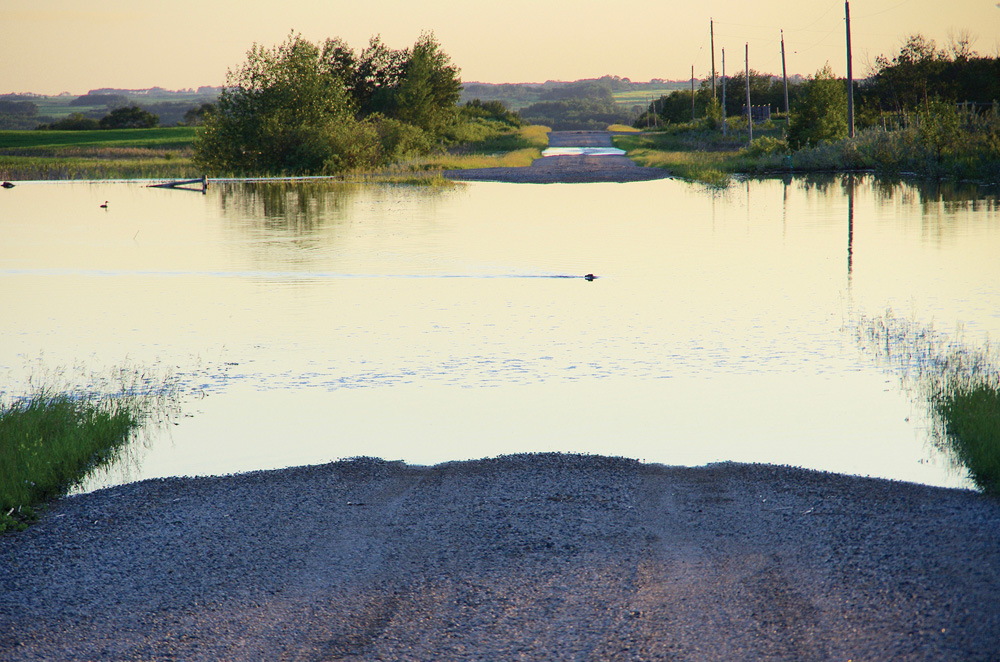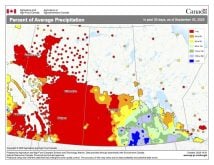Once again, I am in the position of having to write the monthly weather roundup while there are several days left in the month. Due to my deadline being the Friday before you read this, I had to decide whether I should wait one more issue to take our monthly look back and then peer ahead to see what might be in store for us this summer. If I waited, then you would not be reading this until June 8 at the earliest. With this in mind, and with the fact that I have been getting a ton of questions about what this summer is going to be like, I am going to go ahead with the weather roundup and our look ahead at this summer’s possible weather, even though there are still a couple of possibly wet days before the end of May.
If you subtract the snow we saw in April, then May turned out to be almost a carbon copy of April’s weather. Looking at all the numbers across southern and central Manitoba I do not think it will surprise anyone that every station I checked reported well-above-average rainfall in May. What was surprising was the uniformity of the rainfall. Looking at the three major stations of Winnipeg, Brandon and Dauphin, all three reported rainfall amounts within five to 10 mm of 100 mm. This is nearly twice their long-term averages for the month. Combine this with a wet April and, needless to say, it has been a very wet spring. Just how wet? I will take a look at all the numbers once May is totally done and report back to you.
With all that rain, it’s not unexpected that temperatures in May were below average. I am a sunshine person and by the time the last week of May rolled around I was really starting to notice the lack of sunshine over the last couple of months. In the spring, sunshine usually equals nice warm afternoons, and without it, daytime highs struggled to warm up. At least all of the cloud cover did help to keep the overnight lows warm. Looking back at the month there were only about four days that reported frost, with three of those days seeing just a light touch of frost with overnight lows only dropping to around -0.5 C. Even the lack of really cold nights could not overcome the cool daytime highs, and when it was all averaged out, all three stations reported a mean monthly temperature for May that ranged from about 0.5 C below average in Dauphin, to about 1.5 C below average in Brandon.
Read Also

Farmer gift idea: How about a weather station?
The 2025 holiday season is looming, and a home weather station might make a great Christmas gift for farmers
Who called it?
So, it was a cold and wet May. Looking back at the different forecasts, the winner for best May prediction goes to… the Canadian Farmers’ Almanac, followed closely by the CFS weather model. Both predicted cooler- and wetter-than-average conditions, but the Canadian Farmers’ Almanac appeared to call for more extreme rainfall than what we saw. On the other side of the coin, the worst forecasts were the Old Farmer’s Almanac, which called for well-above-average temperatures and precipitation, and my forecast for above-average temperatures and near-average precipitation. I could argue that the CanSIPS model was pretty bad too, with a May prediction of near-average temperatures and below-average precipitation.
OK, now on to the latest summer forecasts — but before we get there, always keep in mind that if anyone says their forecasts are almost always right, then they should be wealthy beyond anyone’s dreams. If they are not, then take what they say with a grain of salt. Our five- to 10-day forecasts are getting pretty good, but the three-month forecasts still have a way to go.
As usual, we will start with the almanacs. The Old Farmer’s Almanac calls for near-average temperatures in June cooling to below average by August. June will be a dry month with July and August seeing above-average rainfall. The Canadian Farmers’ Almanac seems to be calling for near- to above-average temperatures in June along with near-average precipitation. I still cannot access its detailed longer-range forecasts, but the summer forecast map it put out is calling for sizzling temperatures and showery weather. So, that sounds like warmer than average with near-average rainfall… ?
Moving on to the different weather models. NOAA’s three-month summer outlook calls for an equal chance of seeing either below- or above-average temperatures and precipitation. I usually take this type of forecast as meaning near-average conditions. Next up is the CFS model and it is predicting near- to slightly below-average temperatures across the southern Prairies with near- to slightly above-average temperatures over more-northern regions (see this issue’s weather map). The precipitation forecast is for above-average rainfall across southern regions with near-average amounts in the north. The latest CanSIPS or Canadian weather prediction for this summer does not come out until June 1, so I will update you on that forecast in the next issue.
If you are hoping for a hot, dry summer, then The Weather Company’s summer forecast is for you. It calls for a repeat of last summer with hot and dry conditions dominating. AccuWeather’s summer forecast calls for warm and dry weather across the western and central Prairies with Manitoba seeing near-average temperatures and precipitation.
Last on the list of weather predictions is my own. My gut, which has not been predicting the weather very well lately, is calling for a slightly warmer- and wetter-than-average summer.
Now it is time to cross our fingers and wish that everyone ends up getting exactly the type of weather that they need this summer.
















